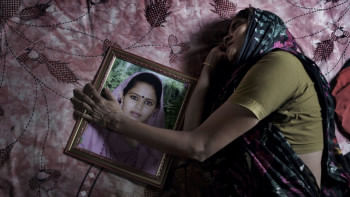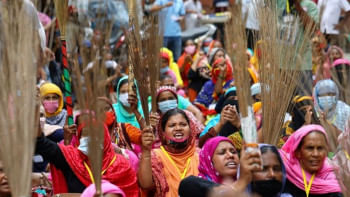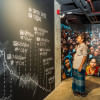Let not Rana Plaza fade from public memory
Ten years have passed since the Rana Plaza disaster shook the global garment industry to its core, claiming the lives of over 1,100 workers and leaving thousands injured. The tragedy, along with the Tazreen Fashion factory fire just months earlier, exposed the dire state of the ready-made garments (RMG) industry in Bangladesh – poor factory safety, unequal power relations and practices in the global fashion supply chain, and gaps in worker rights. In the aftermath of this catastrophe, various initiatives were launched to address the systemic issues plaguing the industry. Brac Institute of Governance and Development (BIGD), in collaboration with the Accountability Research Center of the American University, comprehensively reviewed the progress made in factory safety and workers' protection and highlighted issues and areas for further improvement, which are required to build an RMG industry that is fit for middle-income, 21st century Bangladesh.
The Rana Plaza disaster has been extensively documented by policymakers, academic researchers, trade unions, and activists. Yet, the tragedy seems to be fading from public memory, particularly among younger workers. The physical site of Rana Plaza now stands as an empty plot scattered with debris, marked only by a sombre statue erected by workers. Unfortunately, younger workers and new migrants to the area seem to be unaware of the historical significance of the event that unfolded at this location just a decade ago. Although the government initially promised to hand over the Rana Plaza land to workers so that they could construct a hospital or another memorial, those promises remain forgotten. Still, worker advocates continue to pursue them. The absence of official commemorations, other major stakeholders' lack of recognition of the anniversary of the tragedy, and limited reference of Rana Plaza in national policy documents raise concerns about the collective memory and commitment to bring about structural changes in our RMG industry.
As mentioned earlier, many initiatives were taken in Bangladesh following the collapse to improve the industry. There was the Sustainability Compact, which claimed its success in terms of an improved legislative environment and freedom of association. We also had the Accord on Fire and Building Safety in Bangladesh, the largest initiative, which made significant progress in promoting workers' representation and participation in the global supply chain and holding brands accountable, and the Alliance for Bangladesh Worker Safety, which implemented extensive training and monitoring programmes.
At the global level, foreign governments pledged funding and implemented legal protection measures such as mandatory Human Rights Due Diligence (mHRDD) to safeguard the rights of workers in the global supply chain. The Bangladesh government has taken on more responsibility for factory regulation and workers' rights through efforts such as the amendment of the Bangladesh Labour Act, strengthening of factory inspections, institution of mandatory revision of minimum wage for RMG workers every five years, adoption of the National Occupational Safety and Health Policy, and formation of a cabinet committee on the RMG sector. These measures demonstrate a commitment to increasing transparency and oversight in the industry.
There have been significant changes at the factory level, too. Bangladesh accommodates half of the world's top 100 LEED-certified green industrial buildings, and all but four are in the garment sector. By implementing eco-friendly technologies and improving infrastructure, factories aim to create a healthier and more sustainable work environment.
However, while building safety has been a prominent concern following incidents like the Rana Plaza collapse, there has been a narrow focus on the physical safety, health, and well-being of workers. The underlying processes and internal relationships that create risks for workers' health on the factory floor have been largely ignored. To improve the overall health and well-being of Bangladeshi RMG workers, addressing these underlying factors will involve labour law reform, strengthening workers' rights and unions, and improving working conditions.
Although wages have been revised multiple times, Bangladesh still has one of the lowest RMG wage structures in the world. Moreover, high inflation – particularly of food, energy, and housing costs – means that in real terms, wages have declined. Despite commitments made by leading brands and buyers to ensure decent wages for workers, comprehensive efforts are yet to be made to follow through on these commitments. Buyers should take responsibility for the wages of workers in their supply chains and ensure a living wage. This requires setting clear and enforceable standards for wages and working conditions, and working with suppliers to ensure that these are met. This issue is even more relevant at present, when the RMG sector wage board is set to declare a new minimum wage in August 2023.
Besides, efforts to strengthen workers' rights to freedom of association and collective action have been less notable or successful compared to factory safety initiatives over the past decade. Despite the creation of the Accord and its successor, the RMG Sustainability Council, which provides opportunities for workers' participation in the core steering committee, trade unions remain contentious in Bangladesh with low union membership and limited freedom to operate. To secure decent wages or minimum wage reforms, it is essential that the trade unions are independent and can fully exercise their right to organise and mobilise. Trade unions must be permitted to represent and promote the interests of workers, and workers' voices must inform public policy, particularly around industrial development, social protection, and human rights.
Finally, to ensure workers' right to a decent livelihood, social security in the form of unemployment, health, and accident and injury insurances must be guaranteed by actors in the global supply chain as well as by the state.
To read a longer version of the report on which this article is based, see: Ten Years After Rana Plaza: Remembering, Learning, and Moving Forward.
An exhibition titled '10 Years after Rana Plaza' is taking place from July 21-29 at Drik Gallery, displaying photographs and stories of survivors and their families, by World Press Photo award-winning photojournalist Ismail Ferdous. It is an immersive experience, intended to provide a space for quiet and sombre reflection about the disaster.
Iffat Jahan Antara is a researcher at Brac Institute of Governance and Development (BIGD). Maheen Sultan is senior fellow of practice at BIGD.


 For all latest news, follow The Daily Star's Google News channel.
For all latest news, follow The Daily Star's Google News channel. 










Comments